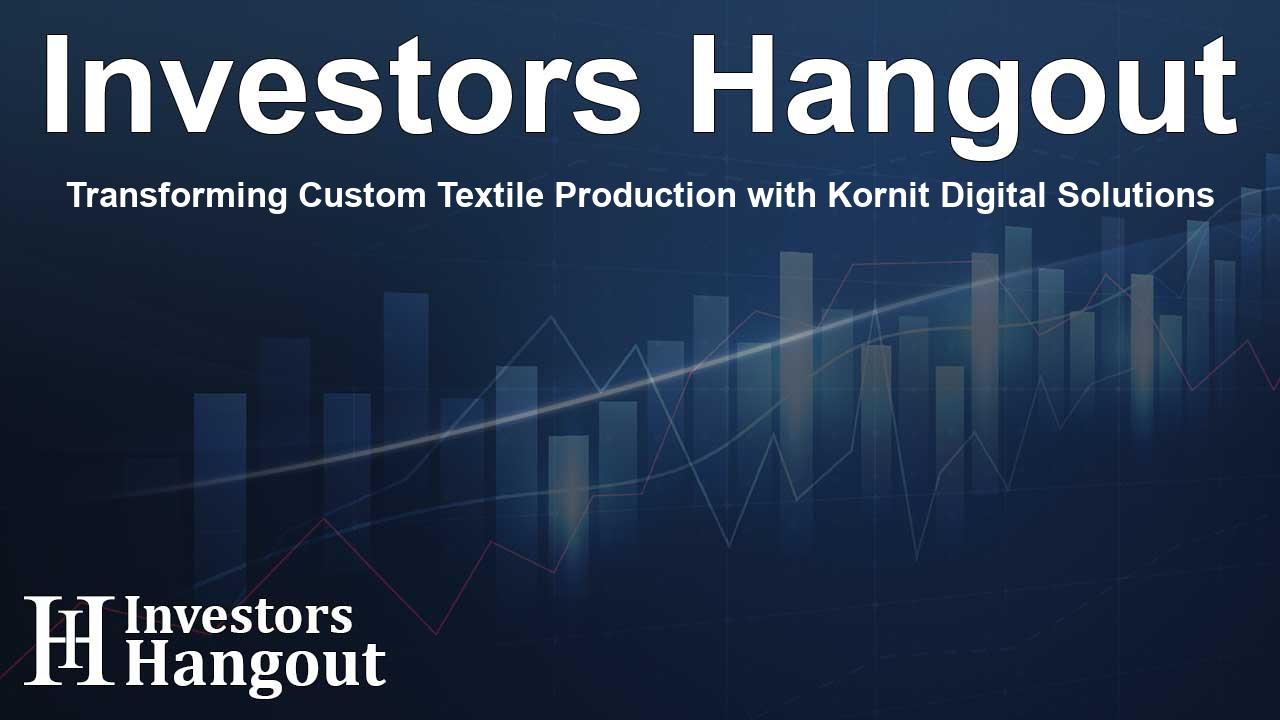Transforming Custom Textile Production with Kornit Digital Solutions

Revolutionizing Custom Apparel Production
In a significant move towards modernizing textile manufacturing, Print Palace Textildruck is actively embracing digital production methods, with a proactive shift from traditional screen printing to on-demand techniques powered by Kornit Digital. This transformation is shaping the future of custom textiles, ensuring that apparel can meet the rapid demands of customers while maintaining the highest standards of quality.
Kornit Digital: A Leader in On-Demand Solutions
Kornit Digital is at the forefront of sustainable, digital textile production technology. As advertised, their All-Inclusive Click (AIC) Model allows businesses like Print Palace to enhance their production capabilities significantly. Instead of long waiting times typical of traditional processes, the integration of Kornit Apollo technology enables faster turnaround to meet medium-run production requirements efficiently.
Embracing Change in the Textile Industry
The shift from analog to digital is not merely a trend; it's a necessary evolution in the industry. For over 30 years, Print Palace has been a reputable name for producing top-tier merchandise for bands, promotional items, and high-quality apparel. The company's venture into on-demand digital production signifies its commitment to keeping pace with market demands.
Enhancing Productivity with Kornit Apollo
As Print Palace transitions to on-demand, digital production, the Kornit Apollo plays a pivotal role. This production line facilitates handling jobs up to 500 pieces, enhancing speed and agility in fulfilling customer orders. It’s a game-changer that allows the company to stream their screen-printing process, thus improving overall profitability as the two production methods are harmoniously integrated.
The Need for Speed in Customization
The voice of Print Palace’s owner, Volker, emphasizes the necessity for rapid production solutions. He noted the surge in demand for high-quality, uniquely designed apparel. To remain competitive, adapting to these demands is essential; thus, the Kornit Apollo's capacity to deliver products quickly aligns perfectly with this goal. Customers today expect immediate gratification, and the digital production era promises just that.
Customer Expectations Redefined
Today's consumers are less tolerant of long wait times for custom apparel. As Ronen Samuel, CEO of Kornit Digital, points out, creative self-expression in fashion requires immediate fulfillment. The ability to produce vibrant, quality apparel as quickly as possible is crucial to capturing this market. Kornit's innovative solutions equip Print Palace to meet these ever-evolving customer needs seamlessly.
The Future of Custom Textiles
The transition to on-demand production with Kornit Apollo is just the beginning for Print Palace. The PRINTING United Expo showcased the future of textile production, presenting real-time demonstrations of how digital capabilities can significantly change the landscape of the industry. As they continue to explore these technologies, Print Palace is set to redefine customer experiences with their products.
A Global Perspective on Sustainability
Kornit Digital is committed to sustainability in the textile industry. With its innovative digital printing systems, Kornit is not only transforming apparel production but also doing so in an eco-conscious manner. By minimizing waste and promoting on-demand practices, it's possible to create a more sustainable future for fashion.
Conclusion: Print Palace's Bright Future
The trajectory of Print Palace Textildruck showcases a path that many textile manufacturers are starting to consider. By shifting to digital production with the aid of Kornit Digital technologies, they not only enhance their operational efficiency but also position themselves as leaders in the custom apparel market. As the demand for personalized merchandise and rapid manufacturing ramps up, companies able to adapt will undoubtedly thrive in this dynamic landscape.
Frequently Asked Questions
What is the main reason for Print Palace's transition to digital production?
Print Palace is transitioning to digital production to streamline operations, meet higher customer demands for quick turnaround times, and enhance product quality.
What technology is involved in Print Palace's production shift?
The transition involves the Kornit Apollo production line, which allows for efficient on-demand, digital textile production.
How does the Kornit Apollo improve productivity?
The Kornit Apollo enables Print Palace to handle medium-run jobs quickly and efficiently, enhancing speed and agility while maintaining high-quality outcomes.
Why is on-demand production becoming more important?
On-demand production is becoming essential to respond swiftly to customer preferences for unique, vibrant designs and rapid fulfillment.
What future steps is Print Palace considering after this transition?
After the transition to digital production, Print Palace aims to continually leverage Kornit Digital's technologies to push boundaries in quick, quality apparel manufacturing.
About Investors Hangout
Investors Hangout is a leading online stock forum for financial discussion and learning, offering a wide range of free tools and resources. It draws in traders of all levels, who exchange market knowledge, investigate trading tactics, and keep an eye on industry developments in real time. Featuring financial articles, stock message boards, quotes, charts, company profiles, and live news updates. Through cooperative learning and a wealth of informational resources, it helps users from novices creating their first portfolios to experts honing their techniques. Join Investors Hangout today: https://investorshangout.com/
Disclaimer: The content of this article is solely for general informational purposes only; it does not represent legal, financial, or investment advice. Investors Hangout does not offer financial advice; the author is not a licensed financial advisor. Consult a qualified advisor before making any financial or investment decisions based on this article. The author's interpretation of publicly available data shapes the opinions presented here; as a result, they should not be taken as advice to purchase, sell, or hold any securities mentioned or any other investments. The author does not guarantee the accuracy, completeness, or timeliness of any material, providing it "as is." Information and market conditions may change; past performance is not indicative of future outcomes. If any of the material offered here is inaccurate, please contact us for corrections.